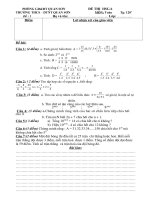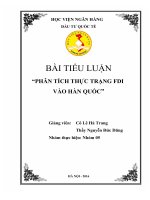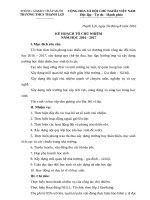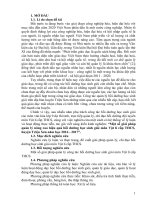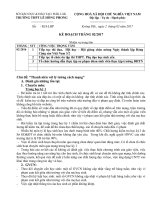cmt1 sample c 2016
Bạn đang xem bản rút gọn của tài liệu. Xem và tải ngay bản đầy đủ của tài liệu tại đây (981.76 KB, 42 trang )
1. Which of the following statements is a recommendation of the CFA Institute Standards of
Practice Handbook with regard to personal investing?
i.
Restrictions on participation in equity IPOs
ii.
Preclearance of significant value trades only
iii.
Disclosure of holdings in which the employee has a beneficial interest
iv.
Voluntary disclosure of holdings in which the employee has a beneficial interest
a) i and ii
b) i and iii
c) i, ii and iii
d) I, ii and iv
2.
a)
b)
c)
The mosaic theory approach means that a member:
can use material public information or nonmaterial nonpublic information in analysis.
can use material non-public information or nonmaterial public information in analysis.
violates the CFAI Code and Standards if he/she fails to have the knowledge of and comply
with all applicable laws.
d) should include all available and relevant information in a research report in support of an
investment recommendation.
3. Gaji is a financial analyst with XYZ Brokerage Firm. He is preparing a purchase
recommendation on JNI Corporation. Which of the following situations is most likely to
represent a conflict of interest for Elizabeth that would have to be disclosed?
a) Gaji’s brother-in-law is a supplier to JNI.
b) Gaji frequently purchases items produced by JNI.
c) XYZ holds for its own account a substantial common stock position in JNI.
d) Gaji’s experience with purchasing items produced by JNI has been extremely positive.
4. Emily Meyers is an analyst with a large pension management firm. Her personal portfolio
includes a significant investment in MB Corp. common stock. She receives a call from
the Director of Research asking her to analyze MB Corp. According to the CFAI Code
and Standards, Meyers should:
a) sell her shares of MB Corp before completing the research report.
b) sell her shares of MB Corp before initiating research on the company.
c) disclose the ownership of the stock to her employer and in the report.
d) sell her shares of MB Corp, and buy a mutual fund that has a high portfolio weightage in
MB Corp common stock.
5. Members must keep information about current, former and potential clients confident
unless:
i.
Disclosure helps the members obtain further business from client’s relatives and
friends.
ii.
The information concerns illegal activities on the part of the client.
iii.
Disclosure of the information is required by law.
iv.
The client or prospective client permits disclosure.
a) i, ii and iii
b) ii, iii and iv
c) ii and iii
d) iii and iv
6.
a)
b)
c)
TRIN index is calculated by:
dividing total specialist short sales by total short sales.
subtracting the 26-day simple moving average from the 12-day simple moving average.
subtracting the advance/decline ratio by the ratio of advancing volume to declining
volume.
d) dividing the advance/decline ratio by the ratio of advancing volume to declining volume.
7.
a)
b)
c)
d)
_______charts are the most useful, practical, and visual of all charting systems.
Line
Candlestick
EquiVolume
Point & Figure
8. Of the following, which indicator is most likely to be valuable in determining when to
execute a trend-following trading system?
a) Average true range (ATR)
b) New Highs, New Lows index (NHNL)
c) Volume weighted average price (VWAP)
d) Directional Movement Indicator (ADX)
9.
a)
b)
c)
d)
If the price makes a series of higher highs while the OBV indicator does not, it indicates:
Sell signal
Bullish divergence
Bearish divergence
Both A and C
10. When analyzing candlestick price charts, a long black candlestick appearing after an
uptrend with high volume, it is most likely to act as a:
a) reversal.
b) continuation.
c) consolidation.
d) rising momentum.
11. When analyzing an open interest, prices are in a downtrend, and open interest is rising, it
implies a:
a) bullish sign.
b) bearish sign.
c) falling momentum.
d) rising momentum.
12. Unchanged issues index is calculated by:
a) dividing the number of advancing stocks by the number of declining stocks.
b) subtracting the number of declining stocks from the number of advancing stocks.
c) subtracting the number of unchanged stocks from the number of total issues traded.
d) dividing the number of unchanged stocks by the number of total issues traded.
13. A candlestick that has a long lower shadow, emerging after an extended downtrend
suggests that:
a) buyers have lost momentum.
b) sellers have lost momentum.
c) both buyers and sellers have lose momentum.
d) lack of decisive control by either buyers or sellers.
14. A runaway gap is often found:
a) at the end of a significant move.
b) in the middle of a significant move.
c) at the beginning of a significant move.
d) after the announcement of a surprising but rumored news release.
15. Which of the following candlestick pattern combines a consecutive set of sessions into a
single candlestick?
a) Blending
b) Marubozu
c) Moring star
d) Bullish engulfing
16. Which of the following is used to identify the potential reversal levels?
a) The RSI
b) The Ichimoku clouds
c) The Fibonacci extension
d) The Fibonacci retracement
17. An Exhaustion gap usually occurs:
a) in the middle of the existing uptrend.
b) at the beginning of a new trend with high volume.
c) during the accumulation phase of the market cycle.
d) near the end of an existing trend with high volume.
18. Which of the following retracement levels are most likely use:
a) 62%
b) 38%
c) 66%
d) Both A and B
19. Which of the following cycles is the longest by duration?
a) Decennial Pattern
b) Presidential Cycle
c) Kondratieff Cycle
d) 34-year Historical Cycle
20. Serial correlation or autocorrelation means:
a) that there is persistence in the data.
b) that a false correlation in the data automatically appears.
c) there is no discernible relationship between the two variables.
d) that the relationship between the two variables is greater than 5.
21. Which of the following types of gaps are quickest to close?
a) Area gaps
b) Runaway gaps
c) Exhaustion gaps
d) Continuation gaps
22. If the daily returns are constant, they can be converted to annualized risk by multiplying
the daily return with the square root of:
a) 252.
b) 260.
c) 360.
d) 365.
23. Typically, the _______year of a president’s term posts the strongest returns for the
market as per the presidential cycle.
a) First
b) Second
c) Third
d) Fourth
24. Which of the following bonds exceed rating thersholds set by S&P, Moody’s and Fitch?
a) Junk bonds
b) High-yield bonds
c) Investment-grade bonds
d) Corporate Class A bonds
25. Political risk refers to:
a) the potential of a credit rating upgrade to positively impact investments.
b) the potential of depreciating currency to negatively impact investments.
c) the potential of a credit rating downgrade to negatively impact investments.
d) the potential of legislative actions to deter companies from reaching their goals.
26. Bottom-up analysis refers to an analysis of/for:
a) the monetary policy.
b) company fundamentals.
c) overall economic and business condition.
d) a specific government, company, (or) asset.
27. LIBOR is a benchmark for:
a) Fed fund rate.
b) Consumer loans.
c) Commercial loans.
d) Commercial and consumer loans.
28. If someone says that Eastern Technical Analysis and Western Technical Analysis
together augment the overall recognition of trends, what are they likely to be explaining?
a) How different cultures work together to better understand market prices.
b) How Shanghai markets affect New York markets and how the reverse is also true.
c) That Candlesticks and Bar charts have the same patterns but with different names.
d) That candlestick charts used with oscillators and other technical studies can be productive.
29. Calculate the real return based on the information provided below:
The S&P 500 index fell 0.003 percent in 2015.
Dividends paid during the year equaled 2.089 percent of the index’s value.
Inflation was 3.4 percent, based on the change in the Consumer Price Index (CPI)
for the 10 months ended in November
a) -2.08%
b) -1.30%
c) 1.30%
d) 2.08%
30. _______are securities that the U.S. government sells to borrow funds for a year or less.
a) Debentures
b) Treasury bills
c) Commercial paper (CP)
d) Certificates of deposit (CDs)
31. _______rates indicate the annual return from owning a property.
a) Prime rate
b) Coupon rate
c) Fed fund rate
d) Capitalization
32. Which of the following statements is an important assumption of the Efficient Market
Hypothesis?
a) Investors as a group will act rationally
b) Investors as a group will act irrationally
c) Prices typically do not reflect all available information
d) Liquidity constraints may sometimes drive prices away from their intrinsic value
33. The CBOE Volatility Index (VIX) is a measure of:
a) 30-day implied volatility as priced by the S&P 500 index option market.
b) 30-day historical volatility as priced by the S&P 500 index option market.
c) 30-day implied volatility as priced by the NYSE Composite index option market.
d) 30-day implied volatility as priced by the NASDAQ Composite index option market.
34. Basis points are:
a) tenth of a percentage point.
b) one fifth of a percentage point.
c) one third of a percentage point.
d) hundredths of a percentage point.
35. The S&P/Case-Shiller indexes reflect:
a) Home sales across the U.S. and in 20 metropolitan areas.
b) Home sales across the U.K. and in 20 metropolitan areas.
c) Home sales across the U.S. and in 10 metropolitan areas.
d) Home sales across the U.K. and in 10 metropolitan areas.
36. The benchmark grade of U.S. oil is commonly called:
a) NFC
b) WTI
c) WCS
d) Brent
37. _______ give investors the option to sell them back before maturity.
a) Treasury bills
b) Putable bonds
c) Callable bonds
d) Convertible bonds
38. In_______markets, gold and other commodities are sold for immediate delivery.
a) spot
b) futures
c) primary
d) secondary
39. Which of the following is a commonly used tool by the Federal Reserve to set a target
rate that is aimed at containing inflation and maximize employment?
a) Discount rate
b) Federal Funds rate
c) Open market operations
d) Bank reserve requirements
40. A symmetrical triangle pattern contains at least:
a) two lower highs and two lower lows.
b) two lower lows and two higher lows.
c) two lower lows and two higher highs.
d) two lower highs and two higher lows.
41. Breakouts from a rectangle pattern occur when:
a) price fails at either of the bounds of the pattern.
b) price closes outside the boundary of the pattern.
c) price crosses the halfway point of the pattern from above.
d) price crosses the halfway point of the pattern from below.
42. When analyzing a pattern, the top trend line is horizontal and the bottom line slopes
upward, which is called as a/an:
a) ascending triangle.
b) descending triangle.
c) broadening triangle.
d) symmetrical triangle.
43. A downtrend line has:
a) a positive slope and is formed by connecting two or more low points.
b) a positive slope and is formed by connecting two or more high points.
c) a negative slope and is formed by connecting two or more low points.
d) a negative slope and is formed by connecting two or more high points.
44. A bear trap occurs when:
a) prices fail to surpass a clear resistance level and sell off from it.
b) prices close above a resistance level after sell signals are generated.
c) prices breakout above a clear resistance level and fall back below it.
d) prices recapture a violated support level after sell signals are generated.
45. In Elliott wave theory, impulse and diagonal are called:
a) motive waves.
b) corrective waves.
c) triple-combination.
d) double-combination.
46. Which of the following is CORRECT according to Elliott wave theory?
a) Wave four can never enter the price territory of wave one
b) Wave two can never retrace more than 100% of wave one
c) Wave three can never be the shortest of the three impulse waves
d) All of the above
47. In a Zigzag corrective pattern, wave C is:
a) an impulse.
b) an ending diagonal.
c) a Leading diagonal.
d) A or B.
48. For futures contract, daily volume represents:
a) the sum of total volume and open interest.
b) the number of contracts traded during the day.
c) the number of outstanding contracts in any given day.
d) the number of outstanding contracts in first day of the month.
49. The Force Index is negative_______
a) when the previous day close is below the current day close.
b) when the current day close is below the previous day close.
c) when the previous day volume is greater than the current day volume.
d) when the current day volume is greater than the previous day volume.
50. OBV indicator is:
a) a running total of volume.
b) acting as a leading indicator.
c) each day’s volume is added or subtracted, depending on whether prices close higher or
lower than on the previous day.
d) all of the above.
51. _______gives the highest weightage in technology companies.
a) The DJIA index
b) The S&P 500 index
c) The Value line index
d) The NASDAQ composite index
52. In a double top pattern, volume is generally:
a) rising throughout the pattern.
b) constant throughout the pattern.
c) lower on the left top than the right.
d) higher on the left top than the right.
53. ______pattern is thin, narrow price spikes and often composed of a single day or two.
a) Eve bottom
b) Adam bottom
c) Island reversal
d) Dead cat bounce
54. A falling relative strength line for a stock in a rising market indicates that:
a) price and volume are diverging.
b) the stock is performing better than the market.
c) the stock is performing worse than the market (on an absolute basis).
d) the stock is performing worse than the market (on a relative basis).
55. The resistance level of a price trend refers to:
a) the target price indicated by the count.
b) the boundaries of the trading range of the trend.
c) the level under the market where buying interest is sufficiently strong to overcome selling
pressure.
d) the level over the market where selling pressure is sufficiently strong to overcome buying
pressure and a price advance is expected to be turned back.
56. When the market is under pressure, there is a net buying of_______, which will result
in_______.
a) put option, lower implied volatility
b) put option, higher historical volatility
c) call option, higher historical volatility
d) put option, higher implied volatility
57. _______has historically had an inverse relationship to performance of the S&P 500
index.
a) The VIX index
b) The Value line index
c) The Herrick payoff index
d) The S&P/Case-Sheller home price index
58. Which of the following is an input of an option price model?
a) The dividend
b) The type of option
c) The strike price of the option
d) All of the above
59. In a double bottom pattern, the chart pattern confirms:
a) when price close above the 200-day SMA.
b) when price close above the highest peak of left bottom.
c) when price close above the highest peak of right bottom.
d) when price close above the highest peak between the two bottoms.
60. Dow theory uses only:
a) High
b) Low
c) Close
d) Open
61. Which of the following formations is often called a coil?
a) Flag
b) Wedge
c) Zigzag
d) Symmetrical Triangle
62. A security has just broken out of its trading range to the upside. Over the course of the
next 2 days it rises an additional 5% from the point of the breakout and then returns to its
prior resistance line before continuing the uptrend. What term best describes this
behavior?
a) Bull trap
b) Pullback
c) Throwback
d) False breakout
63. The moving average:
a) follows the trend.
b) lags market action.
c) is a smoothing device.
d) All of the above
64. The Dow Jones Industrial Average index is a________weighted index.
a) price
b) trade
c) equal
d) market-cap
65. All the following are momentum oscillators EXCEPT:
a) Stochastic.
b) Advance/Decline line.
c) Relative Strength Index (RSI).
d) Moving Average Convergence Divergence (MACD).
66. A doji candlestick represents:
a) supply exceeds demand.
b) demand exceeds supply.
c) stocks volatility.
d) supply and demand are in balance.
67. A stock trades in a range between 51 and 55 for 10 days and then moves higher. If you
have been charting the stock with a 3 box reversal point & figure chart, with 2 point
assigned per box, what would the horizontal count be?
a) 30 points
b) 10 points
c) 60 points
d) There would be no count
68. As a general rule in rectangle, triangle, flag and pennant patterns, volume generally:
a) show signs of accumulation.
b) increases as the pattern develops.
c) decreases as the pattern develops.
d) stays constant as the pattern develops.
69. ________occurs after a downtrend breakout from a chart pattern when price returns to
the breakout point or chart pattern boundary within 30 days.
a) A pullback
b) A throwback
c) A dead cat bounce
d) A corrective wave
70. Which of the following is a reversal pattern?
a) Flag
b) Pennant
c) Rising wedge
d) consolidation
71. Which of the following usually show support or resistance?
a) Gaps
b) Trend line
c) Major highs or lows
d) All of the above
72. In Point & Figure chart,_______determines the sensitivity, (or) frequency of signals.
a) the box size
b) the high pole
c) the vertical count
d) the horizontal count
73. Using intraday 1X1 point & figure charts, which breakout is most significant?
a) A breakouts are of equal significance
b) A breakout from a 5 column congestion zone
c) A breakout from a 10 column congestion zone
d) A breakout from a 15 column congestion zone
74. _______mean is used in economics for price analysis.
a) The Harmonic
b) The Quadratic
c) The Arithmetic
d) The Geometric
75. You are updating point & figure charts. They are 5X1 charts. The most recent posting is
$75. The day’s trading begins at $75.55. A rally ensues that takes the stock up to the
day’s high of $77.88. A decline sets in for the rest of the day and the stock closes at the
low of $71.23. How many new posting will you be making on the chart to reflect today’s
trading?
a) 0
b) 1
c) 2
d) 5
76. Which moving average(s) assign GREATER weight to the most recent data?
a) Simple
b) Weighted
c) Exponential
d) Both B and C
77. The Sharpe ratio is a measure of:
a) risk.
b) volatility.
c) performance.
d) standard error.
78. Kurtosis refers to the:
a) peakedness or flatness of a distribution.
b) amount of distortion from a symmetrical distribution.
c) measures of dispersion that describe the shape of the data points.
d) persistence in data that suggests future data can be predicted using past data.
79. The Treynor ratio is calculated by:
a) the annualized return divided by annualized risk.
b) the annualized return divided by maximum drawdown.
c) the annual return less the risk-free return and all divided by beta.
d) the annualized return less the risk-free return and all divided by annualized risk.
80. Objective technical analysis methods are:
a) producing more returns.
b) producing less returns.
c) producing less signals.
d) well-defined procedures that issue unambiguous signals.
81. Which of the following principles describes a characteristic of related cycles?
a) Harmonics
b) Phase shift
c) Summation
d) Fourier analysis
82. If the fund has a beta of 0.5, then it has _______ than the overall market.
a) 5% more volatility
b) 50% less volatility
c) 0.5% less volatility
d) 50% more volatility
83. Which of the following model specifically deal with bubbles and crashes:
a) The Market Model
b) The Shleifer Model
c) The Capital Asset Pricing Model
d) The Abreu-Brunnermeier Model
84. Debentures are a type of:
a) secured loans.
b) perpetual loans.
c) unsecured loans.
d) zero coupon bonds.
85. The commitment of Traders report summarizes:
a) the positions of reporting traders on a weekly basis.
b) the positions of non-reporting traders on a weekly basis.
c) buying and selling by commercials and large speculators.
d) the positions of non-reporting and reporting traders on a weekly basis.
86. A minor low is a valley separated by_______days from a lower low.
a) three
b) four
c) five
d) seven
87. If the VIX is quoted at 30, it indicates the market is expecting a movement of about
_______ percent over the next 30 days.
a) 5.66
b) 7.66
c) 8.66
d) 9.66
88. A flag is generally formed by a_______in a bull market or a_______in a bear market.
a) rally, pullback
b) rally, correction
c) correction, rally
d) correction, throwback
89. A combination of declining volume and rising price action is normally associated with:
a) a weak rally
b) a weak pullback
c) a weak throwback
d) a strong price trend
90. Volume spikes in downtrend reflect:
a) retail investors are bottom-fishing.
b) exhaustion, and suggest an imminent reversal.
c) professionals are building fresh short exposure.
d) confirmation, and suggest further downside continuation.
91. A bullish divergence occurs when:
a) both prices and momentum values are rising.
b) both prices and momentum values are falling.
c) prices are rising while momentum values are falling.
d) prices are falling while momentum values are rising.
92. Which of the following cycles is the shortest by duration?
a) Decennial Pattern
b) Kondratieff Wave
c) Presidential Cycle
d) 34-year Historical Cycle
93. The presence of a “fat tail” suggests that:
a) prices are normally distributed.
b) trend following systems do not work.
c) prices are not normally distributed.
d) the price action of major financial instruments can be explained by random distribution.
94. When analyzing the bar charts, the closing price of each bar represents:
a) the maximum power of bulls during that bar.
b) the maximum power of bears during that bar.
c) the maximum power of bulls and bears during that bar.
d) the outcome of the battle between bulls and bears during that bar.
95. As per the theory of contrary opinion, a top in the market is the point of_______and a
bottom in the market is the point of_______.
a) maximum optimism, minimum pessimism
b) minimum optimism, maximum pessimism
c) minimum optimism, minimum pessimism
d) maximum optimism, maximum pessimism
96. A buy signal using the MACD indicator is generated when:
a) the MACD line turns positive.
b) the MACD line turns negative.
c) the MACD line crosses below the signal line.
d) the MACD line crosses above the signal line.
97. _______ is a trade-weighted index.
a) The S&P 500 index
b) The U.S. Dollar index
c) The Russell 2000 index
d) The NASDAQ composite index
98. Risk aversion refers to the assumption that investors prefer a portfolio with:
a) lower returns that represent a lower variance in returns.
b) higher returns but are averse to lower variance in returns.
c) stable returns that represent the lowest variance in returns.
d) higher returns but are averse to higher variance in returns.
99. A Narrow-Range day:
a) indicates a phase of volatility expansion.
b) is normally preceded by a strong sell-off.
c) indicates a phase of volatility compression.
d) is normally preceded by a parabolic price advance.
100.
A curved trendline is normally useful for:
a) stable uptrends.
b) stable downtrends.
c) price consolidations.
d) parabolic price moves.
101.
For calculating Money Flow Index (MFI), the typical price is calculated by:
a) the average of the daily low and close.
b) the average of the daily high and close.
c) the average of the daily high, low and close.
d) the average of the daily open, high, low and close.
102.
a)
b)
c)
d)
Identify the Point & Figure pattern highlighted below:
Upside Breakout of a Triple Top
Upside Breakout of a Spread Triple Top
Upside Breakout of a Descending Triangle
Upside Breakout of an Symmetric Triangle
103.
a)
b)
c)
d)
Truncation
Rising Wedge
Expanded Flat
Ending Diagonal
104.
a)
b)
c)
d)
The Elliott Wave pattern highlighted below is a/an:
Identify the Elliott Wave pattern highlighted (inside the blue circle) below:
Triangle
Rising wedge
Ending Diagonal
Leading Diagonal
105.
a)
b)
c)
d)
flat in a bull market.
flat in a bear market.
zigzag in a bull market.
zigzag in a bear market.
106.
a)
b)
c)
d)
The Elliott Wave pattern highlighted below is a/an:
Identify the Elliott Wave pattern highlighted below:
Zigzag in bear market
Regular Flat in bear market
Running Flat in bull market
Expanded Flat in bull market
107.
a)
b)
c)
d)
Running Triangle in bear market
Contracting triangle in bull market
Contracting triangle in bear market
Running Triangle in bull market
108.
a)
b)
c)
d)
Identify the Elliott Wave pattern highlighted below:
Identify the Candlestick pattern highlighted below:
Dragon Fly Doji
Gravestone Doji
Long-legged Doji
Long Upper Shadow
109.
a)
b)
c)
d)
a triple top.
an island top.
a double top.
a three Buddha pattern.
110.
a)
b)
c)
d)
The chart formation highlighted (inside the blue box) below is:
Identify the candlestick pattern highlighted (inside the blue box) in the chart:
Hammer
Evening star
Morning star
Inverted hammer
111.
a)
b)
c)
d)
Evening star
Evening doji star
Dark cloud cover
Bearish engulfing
112.
a)
b)
c)
d)
Identify the candlestick pattern highlighted (inside the blue box) in the chart:
Identify the Point & Figure pattern highlighted below:
Spread Triple Bottom
Descending Triple Bottom
Descending Double Bottom
Breakout of a Triple Bottom


